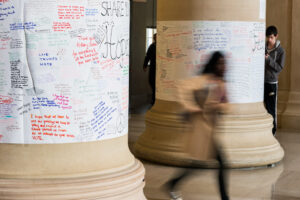
Photo: Justin Knight
Last November, the morning after the presidential election, MIT students wrapped blank posters around the pillars in Lobby 7 to give their classmates a space to write their hopes and fears in a place that was both public and safe.
The posters asked open-ended questions: What do you want to know? Share your hopes. Share your fears. What should we do next? Hundreds of people stopped to write. Within a matter of days, the MIT Libraries’ Institute Archives and Special Collections (IASC) decided to preserve and digitize the posters as part of the memory of MIT, rallying resources throughout the Libraries to help.
This was an act that Tom Rosko, the head of IASC, calls “archiving in real time.” Preserving an object immediately after it is created is a departure from the traditional archival practice of letting some time pass before deciding what has historical value. But it made sense in this situation, Rosko says, because the election was a historic moment and the national reaction so divided.
“The record of history is generally kept and presented by the people in power,” Rosko says. “And those who are marginalized or those who are transient— like students—don’t get to tell their perspectives.”
Recent advances in technology, from social media to better scanning capabilities, have helped create historical records and make them accessible faster than ever. With the flood of information, IASC has started to shift its processes to be able to do this kind of work better, Rosko says: “It’s only recently that we’re able to quickly document something, get more information about it, and then turn around and share it.”
Archiving in real time has its complications—archivists are often emotionally close to the subject—but one of the biggest advantages is that the creators of records are present and able to contextualize their work. It also supports one of the particular interests of the IASC and the Libraries: Getting all sides of a story that is unfolding right now.
View the posters online at libraries.mit.edu/2016-election-posters/
